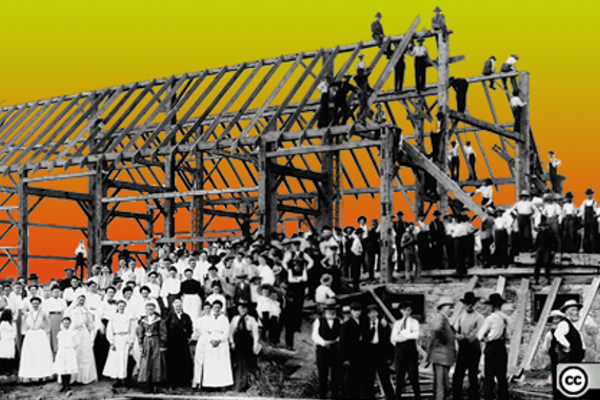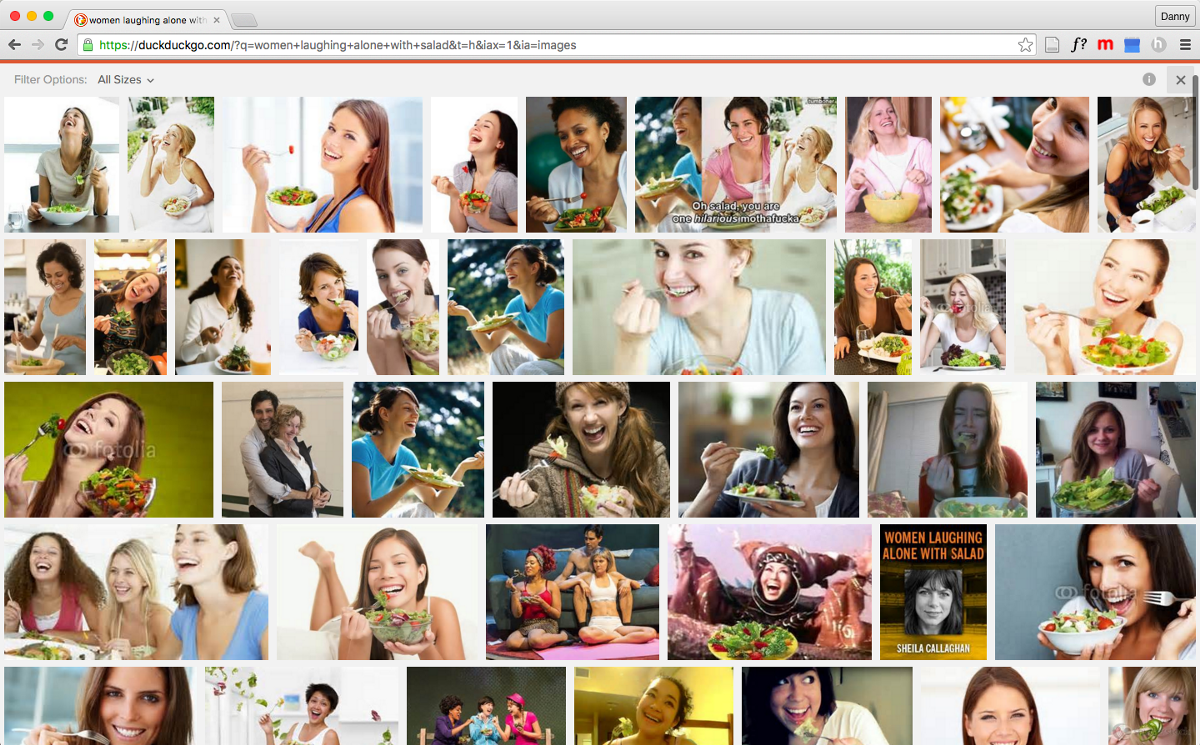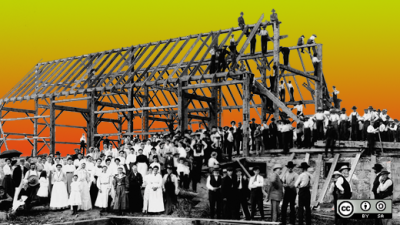
Organizing Barn-Raisers, Not Guilt Parties
“All emotion is involuntary when genuine,” said Mark Twain.
For anyone starting a co-op, this rings true—even more than the first cooperative principle of “voluntary and open membership.”
Co-ops self-organize out of desperation and determination. With emotions running high, and without access to venture capital, co-op organizers romanticize crowdfunding as a digital barn-raiser.
Intuitively, this makes sense: we want to build a beloved community, not tap people out.
In practice, most co-ops struggle with crowdfunding. Very few campaigns lead to what Arlie Hochschild’s The Managed Heart calls “deep acting,” our genuine emotions at work. Instead, organizers fall back on “surface acting,” the kind of behaviour associated with fake smiles and guilt parties. They often strain volunteers, stress supporters, and fail at their goals.
Marketing has skewed our view of crowdfunding by influencing how we think and feel about community.
What does “community” really mean here? Community is collective action with a shared story. We join clubs and co-ops that offer material benefits — things that matter to us on a daily basis — and we stay because of solidarity with our peers and a purpose we can achieve together. The more we act collectively, the more we strengthen these incentives.
Incorporating as a co-op is a long way from building community. There’s a grain of truth to the idea that co-ops are the original crowdfunding, yet people experience them in our organizing and campaigns, not the bylaws or business plans we might be tempted to show them.
We can’t extract generosity through crowdfunding — that’s what marketing tries to do in platform capitalism. Instead, we must form relationships rooted in reciprocity.
I learned these lessons last year, when I partnered with Loconomics to grow their membership and crowdfund their platform.
On paper, Loconomics had a beautiful model: a local services co-op owned by the freelancers doing the work. The user-owners get tools for booking clients, a growing marketplace, and a dividend based on the co-op’s performance. But the appeal of joining a co-op needed as much validation as the platform itself.
To research freelancer needs, I interviewed a representative group of a dozen local service providers — some with their own client base, others taking odd jobs on platforms like TaskRabbit. Nobody felt misinformed, much less exploited, with what they get through on-demand service platforms. However, everone craved the feeling of belonging to something bigger. A part-time plumber with a philosophy degree described the ideal as “less a client base, more a partner base” — in other words, a co-op. But, would anyone pay to join one?
People will give endless feedback on ideas, but only commit if they see value. A sure way to make this shift is through opportunities for people to test a prototype and express their emotions.
Emotions on the Internet
For anyone who has run a crowdfunding campaign, mobilizing genuine emotion can sound like difficult, draining work.
After working in dozens of campaigns, I’ve seen a tension play out between crowdfunding and membership. Crowdfunding is a one-off moment of collection action, but when the projects that we care for also take care of us, people come together and stay together.
How might we reinvent crowdfunding campaigns so collective action continues?
It’s tempting to search for answers on the Internet. But before going online, consider the case of a real-life forest:
Neera M. Singh, author of a 2013 forest conservation study in Odisha, India, found a region that challenges the logic of paying individuals to manage resources as market goods. She observed how villagers harvest only what food and wood they need from the forest, and sing songs celebrating its cool breeze, too. Singh concluded that community stewardship sustains thousands of villages because people organize their labor both effectively — forming accountable relationships around their work, and affectively — developing shared identity in the process.
The story of stewardship in Odisha shows another side of crowdfunding and collective action. While starting a project might depend on pooling financial contributions, sustaining it requires emotional investment.
How do emotions look in Internet marketing? Query your favorite search engine for “women laughing alone with salad,” and you’ll see a cliché used to evoke health and happiness.

I suggest taking a look if you haven’t recently — partly because it’s hard not to laugh at the fake emotions, but mainly because a similar caricature shows up in how on-demand service platforms market themselves. TaskRabbit, for example, portrays images of smiling helpers cleaning kitchens while women hold babies. Unlike stock photos, however, we meet TaskRabbit in real life.
Their marketing may be full of clichés, but on-demand service platforms are full of opportunities to become emotionally invested.
Platforms like TaskRabbit leverage our emotional investment to grow their user base. Their user experience is designed to delight us, especially at key moments around transactions. When interacting with a chef, host, or any service provider who loves their job/gig, we enjoy acts of kindness that have little to do with rating systems. But platforms do not support self-organizing. Instead they leverage community activity to increase user engagement, and resist attempts to leave. TaskRabbit charges a $500 finder’s fee to move consumer-provider relationship off of its platform.
This is the norm in platform capitalism: products extract value from transactions for outside investors. The platforms connect us to resources more than they operate as a resource themselves or a place to gather. In this context, our emotions are more like “laughing alone with salad” and less like singing together in Odisha’s forests.
The real issue with emotions lies with the conditions in which they are extracted. Emotions on the Internet can be better understood with Hochschild’s theory of “emotional labor,” which describes how we adapt our emotional expressions in deep and superficial ways to align with workplace rules. While Singh found villagers laboring happily, defying market logic, Hochschild argued more than 30 years ago that emotions get commodified in a capitalist service economy.
Looking at how emotions change over time, however, shows how people become invested. Beth Hoffman, in a 2015 study of worker co-ops, found that embracing emotion ultimately benefits democratic participation. How? As individuals get comfortable expressing themselves, they develop an identity as co-owners. Hoffman quotes someone from Organix Co-op describing the freedom to be sincerely happy:
If something is great, I say so. If I think everyone is working well, I tell people around me that. Here, I’m free to be enthusiastic. I can get pumped up about the co-op, and it’s not nerdy, or sucking up. Hell, there’s no owner to suck up to. I’m the owner! So I’m not sucking up; I can just tell everyone when things are going great!
Emotional labor in co-ops can undo habits formed in extractive contexts, to the point where co-owners feel like their coworkers and workplace are like “family” and “home.” An office worker at Chemical Cooperative says how:
Where I worked before is a lot worse, a lot worse. Because people there were, spending a lot of time protecting themselves in writing and defending their position... It’s not at all like that here. But it takes some getting used the fact that you can be yourself here. Like you can take your shoes off when you get home.
Such transformative, humanizing experiences in co-ops contrast with how we relate to one another through one-off moments in Internet marketing. It’s also the kind of place where emotional investment grows into stewardship.
Barn-raisers for Stewardship
Happily, my partnership with Loconomics concluded with them focusing on community before launching a product.
 To see what invitation attracts people most, they swapped their full website for a simple sign-up page. And to learn about user experience, they welcomed service providers and clients to events where they could try the app, volunteer, or become owners. Getting together finally made it possible to experience what a community might feel like—a celebration.
To see what invitation attracts people most, they swapped their full website for a simple sign-up page. And to learn about user experience, they welcomed service providers and clients to events where they could try the app, volunteer, or become owners. Getting together finally made it possible to experience what a community might feel like—a celebration.
At a minimum, community is a shared feeling of belonging. These feelings well up when people come together, through book clubs and parties, and they evaporate when the organization shuts down, puts up a pay-wall, or simply has a change of heart. Such precariousness is hidden, however, when a platform manages to balance user satisfaction and extraction.
Building community through crowdfunding plays out in a similar way. It starts with a goal of mobilizing contributions from many individuals. With enough incentives and excitement, the possibility of passing a funding threshold triggers collective action. This usually happens only once. And if a project does get funded, any future collective action depends on whoever owns and controls the value created. Without emotional investment in a cooperative arrangement, campaigns run the risk of ruining relationships over unmet expectations.
Marketing strategies extract generosity and resources by developing an audience, message, and call-to-action, like guilt parties where people leverage relationships unfairly.
For crowdfunding to become stewardship, we need rolling barn-raisers — activities for guests to co-create with their gifts, celebrate their accomplishments, and build again.
A barn-raiser is an organizing strategy for a cooperative alternative that involves people, invitation, and engagement (think P-I-E):
- Connect with people. Audiences are passive, but people put emotions at the core of cooperation. Learn who might join the effort, and what they’re trying to get done.
- Make an invitation. Messages are static, but invitations cultivate voluntary and open membership. Define what you want to celebrate, together — in-person and/or online.
- Sustain engagement. A call-to-action limits inputs, but engagement supports democratic ownership and control. Seek participation more than financial contributions.
By starting small and learning as they go, barn-raisers can “grow the pie” for co-ops. Organizing a crowdfunding campaign can follow the same steps.
This is how a crowdfunding becomes stewardship: raising expectations, embracing the challenge, and sharing the value as community grows.
Go to the GEO front page
Citations
Danny Spitzberg (2016). How Crowdfunding Becomes Stewardship: Organizing Barn-Raisers, Not Guilt Parties. Grassroots Economic Organizing (GEO). https://geo.coop/story/how-crowdfunding-becomes-stewardship

Add new comment